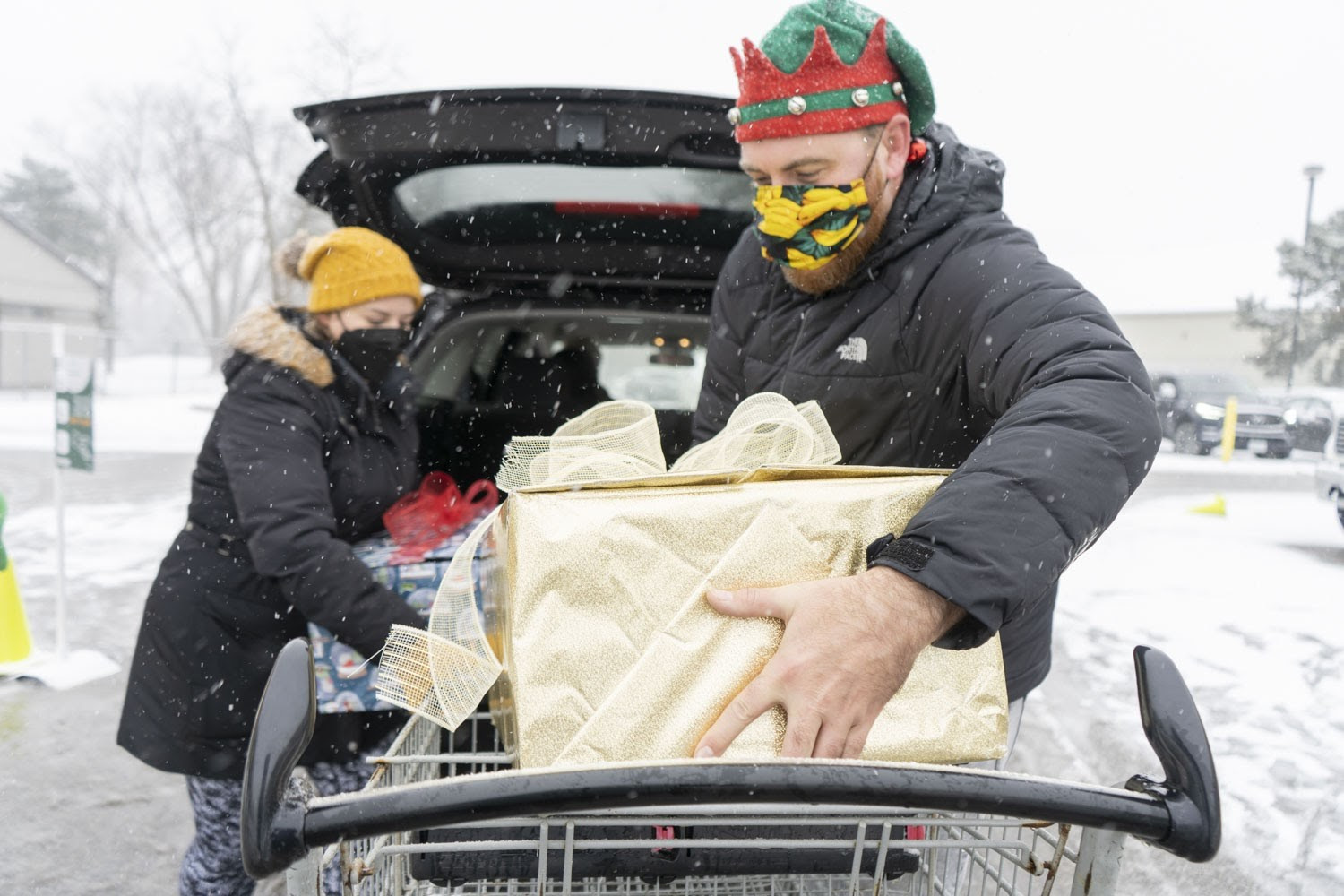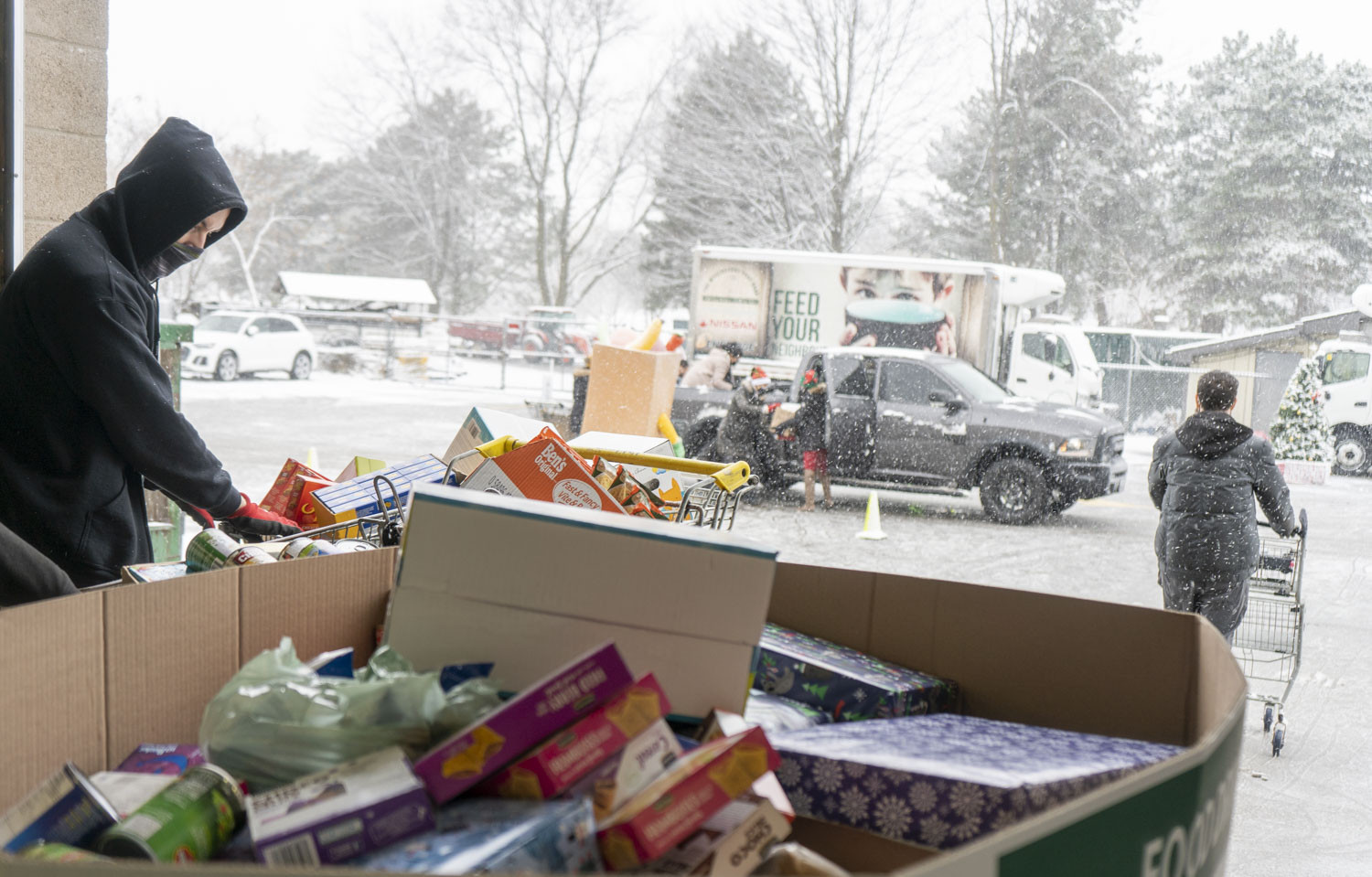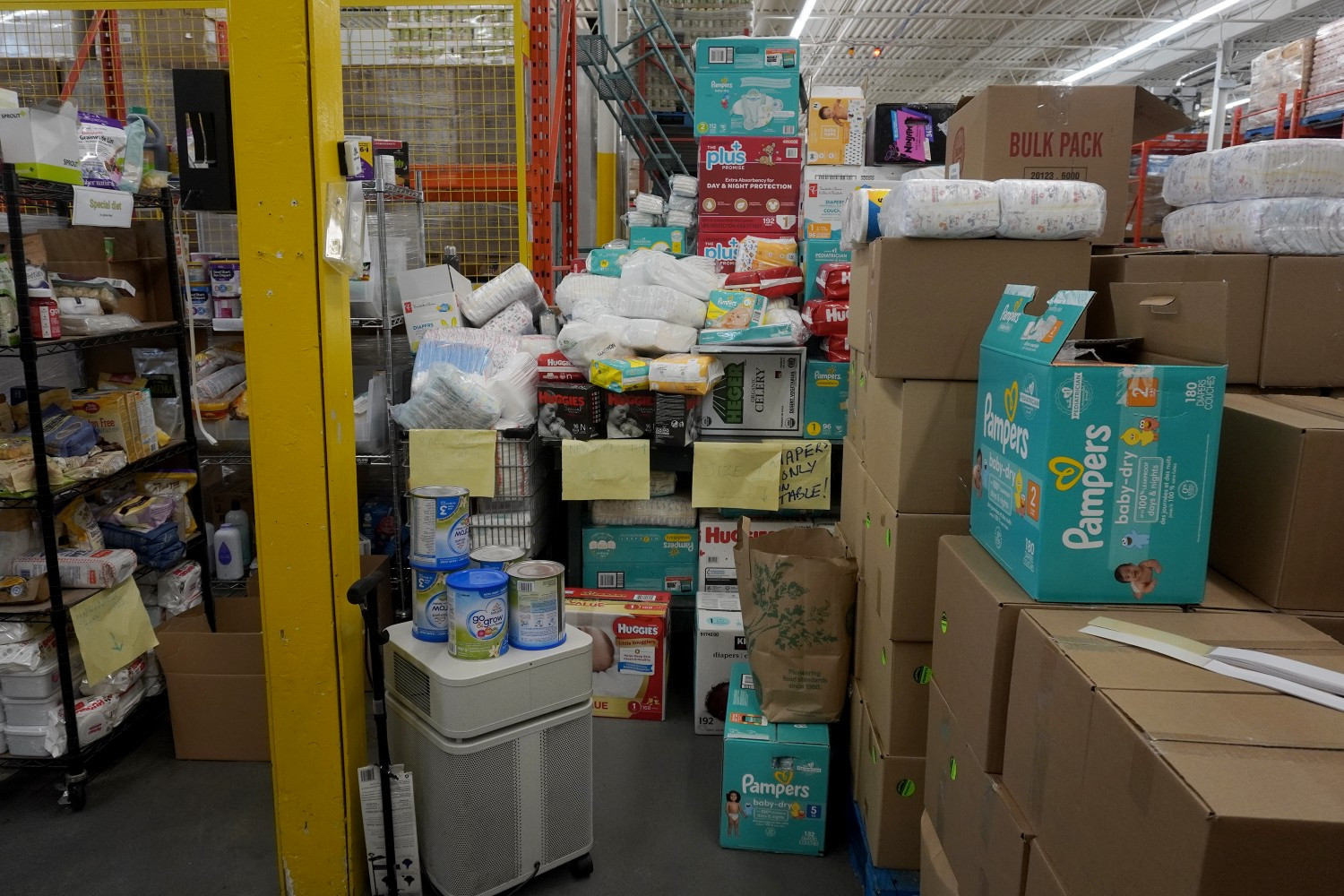
‘The need is greater than we can meet’: Mississauga Food Bank sounds alarm during holiday food drive
“People will go hungry.”
In this festive time of year when so many take the plentiful food shared by family and friends for granted, this is the message to those who rely on The Mississauga Food Bank.
Meghan Nicholls, the organization’s CEO, says the worry is residents might be turned away if resources don’t meet the escalating demand for services.
“Clients [are] saying to us they don't know what to do,” Nicholls says. “Any of the techniques they used in the past, borrowing from one pocket to pay the other kind of thing or holding off on paying one bill because you have to pay another bill this month, even those people are so far below the poverty line, that even those techniques aren't enough to help people make ends meet anymore.”
Turning to food banks is becoming a reality for many in Mississauga and other municipalities as the historic rise in inflation and stagnant salaries are pushing the basic cost of living out of reach for many. The Mississauga Food Bank has been stretching its resources to the breaking point as it struggles to confront the widespread food insecurity plaguing the community.
Meghan Nicholls, CEO of The Mississauga Food Bank.
Food banks have been signaling to policy makers for years that if action is not taken to address systemic food insecurity — exacerbated by increasing prices for fuel and consumer staples — facing residents across the province, ripple effects will be felt as families can no longer afford to feed themselves. Unprecedented strain is being felt by social services agencies working frantically to fill the gap.
Meanwhile, grocery companies such as Loblaw face mounting criticism for profiteering at the expense of Canadians who can barely afford to feed themselves but have little choice. Loblaw's stock price sat at $61.33 on February 26 of last year. About 22 months later, the company’s shares are trading for $125.55, more than doubling in less than two years. While most of the stock market has suffered significant losses this year, and while Canadians run out of options to cope with hyper-inflation, grocery companies like Loblaw appear to be gouging their desperate customers, with no excuse other than to provide massive returns to investors.
This is a major reason for increased food insecurity in places like Mississauga. Many who would usually contribute donations of food or money can’t afford it, as their own grocery bills skyrocket.
While food banks across the province are working to combat the growing demand, resources are finite, and the need is starting to outpace the capacity. With demand hitting an all-time high and resources waning it's coalescing into the perfect storm.
The Mississauga Food Bank has been grappling with a significant increase in demand from vulnerable residents (and even the working class) hit hard over the last two years during the pandemic. Initially, the rapid escalation of food bank use was thought to be the result of an acute set of circumstances related to the COVID-19 pandemic, but almost three years later, food bank use has only continued to increase.
Food insecurity is becoming a crisis as unprecedented numbers of Canadians are now forced to reach out for help and without significant donations this holiday season, the organization could struggle to keep up with the ongoing surge in numbers.
“The desperation level from clients, the worry, the fear of eviction of homelessness, of significant health problems because they're not eating properly, those are the situations that are growing right now,” Nicholls says. “Those are the stories we're hearing more.
“Not to mention the mental health impact of the constant fear and stress and think about the inventions, contributions, meaningful additions to our communities that folks would be able to make if they weren't using so much of their effort and energy and skills and talents just to try and survive.”
The Mississauga Food Bank is continuing to see record breaking numbers of clients accessing the organization's services each month, with October and November hitting unmatched levels. The dynamic has shifted into one so dire that a growing number of people turning to food bank services are employed. Nicholls says “even people who are working now can't make ends meet.”
Feed Ontario released the findings of its 2022 Hunger Report in November, highlighting the ascending severity of the issue.
“A steady growth in low wage work, decades of cuts to our social safety net, and disinvestment in affordable housing put thousands of Ontario families in a precarious position, even before the onset of the pandemic,” the report stated.
It cites precarious employment, poor employment and disability supports, along with unaffordable housing as key drivers behind why people are turning to food banks in unprecedented numbers.
It revealed that nearly 600,000 people accessed emergency food support last year, visiting more than 4.3 million times—an increase of 15 percent and 42 percent (in the two categories) over pre-pandemic numbers from 2019, and the sixth consecutive year that food bank use has risen.
In September, The Mississauga Food Bank’s annual Face of Hunger Impact Report noted more than 5.2 million pounds of food were distributed through the organization in 2021, providing over 5.6 million meals—a 22 percent increase from the year before.
According to the report, visits to the food bank’s more than 50 locations, were up 50 percent from 2021, with 243,194 people utilizing its services; 45 percent of Mississauga residents who live below the poverty line accessed support from The Mississauga Food Bank last year — almost double from the year before.

The Mississauga Food Bank's holiday drive has reached its halfway point with the organization raising approximately 40 percent of its monetary goal.
(The Mississauga Food Bank)
Nicholls says the food bank isn’t raising as much food as it has during the holiday campaign in previous years, noting what’s needed most from the community right now is financial support.
A recent survey in the Hunger Report found that of 140 food banks, two out of three have experienced a noticeable decrease in food donations.
The Mississauga Food Bank recently launched its annual holiday food drive. The yearly campaign is the final opportunity of the year to ensure Mississauga residents have access to reasonable amounts of food during the holiday season. This year the organization hopes to raise $1.7 million and 450,000 pounds of food by January 6 to meet the city’s growing demand.
“Our goals have to be much higher now to have enough to serve the number of people who need us and so, to me, this is starting to say that the need has grown so great, that charitable health isn't enough to meet the need anymore,” Nicholls told The Pointer in October.
As the campaign hits the halfway point, the organization has raised $676,000 in monetary donations, just shy of 40 percent of the goal, and 53 percent of its food goal (238,000 pounds).
In October, the organization hosted its Thanksgiving food drive, raising $706,392, less than half its monetary goal of $1.5 million, and 371,153 pounds of food. Although hundreds of thousands pounds in food was acquired, it still wasn’t enough to meet critical needs in the community.
These ambitious goals reflect the reality that the need and demand for services are escalating at an alarming rate.
With bank lending rates increasing and no indication of support from upper levels of government to provide additional funding for social assistance programs like the Ontario Disability Support Program (ODSP), Nicholls says full service charities like The Mississauga Food Bank are trying to fill the gap created by poor public policies, but it is not sustainable.
In the fall, the province announced a five percent increase to ODSP benefit rates, providing recipients with a maximum of $59 more per month over the previous year. Yet, with the cost of food alone seeing increases of more than 10 percent the increase fell short and recipients are still experiencing an even larger gap between the income they receive and their essential living costs compared to last year.
In 2022, ODSP recipients fell $832 below the poverty line ($64 more than 2021), and Ontario Works recipients face an even greater financial shortfall of $1,327 ($132 more than 2021).
“My concern is that the need in our communities is greater than we can meet,” Nicholls explains. “If the community can't provide the amount of financial support that we need to meet the needs of the huge number of people that we're now helping we're not going to be able to meet the need.
“That's the message of this holiday season: we’ll be turning people away. People will go hungry or we’ll have to give out less food. The community can't support the level of needs that we have now.”
“We need everybody else to step up in ways that maybe they're not feeling they can and so this holiday season is more critical than any holiday campaign has ever been.”
In Mississauga alone, there are currently over 30,000 food bank users, up 16 percent from 2021. Of that 30,000, nearly a quarter are first-time users, a six percent increase from last year. Between 2019 and 2022 there was a 54 percent increase in the number of people served by the organization. Prior to the pandemic, The Mississauga Food Bank had 19,525 clients, as of September 2022 the clientele sat at 30,038. This number is projected to double in less than five years.
The increase in demand since 2014 has been staggering, with 400 percent more food provided now compared to a decade ago. In Mississauga, increase in demand has outpaced most other parts of the GTA for at least five years.
According to the Food Bank’s Canada Hunger Count 2022 report, Canada's food banks saw almost 1.5 million visits in March this year, a 35 percent jump compared to the same time of year in 2019.
These are the consequences of crippling hyper-inflation that could leave lasting scars on the province. Food prices alone have been increasing at a faster rate than any other consumer staple for nearly 12 consecutive months. The price of groceries was 11.4 percent higher in September than the same time last year, the highest food inflation rate since 1981, according to an October update released by Statistics Canada. Cost of transportation has increased by 10.3 percent and shelter costs have risen by 6.6 percent.
Food banks have become a last resort and people are having to choose between buying food and paying for other necessities. Nicholls told The Pointer the organization is seeing people who used to be donors now coming in as clients.
“We're not talking about people saying, ‘I can't go on a vacation I wanted to go on,” she says. “We're talking about people saying, ‘I'm not going to pay my electricity bill, so that I can pay my rent, and I'll try to catch up on electricity next month.’
“These people aren't choosing between the nice to haves. They're choosing between things that are basic needs for us in Canada.”
According to the food bank, about 14.7 percent of the population in Mississauga lives under the poverty line, a measurement that has started to include more traditional “middle class” earners, and roughly 85 percent of the clients are living in poverty.
Current projections from the organization predict it will be providing food to 60,000 people by 2027, double the current number of clients in less than half a decade. The biggest factor contributing to the growing demand is inflation and cost of living which are far outpacing income increases. One of the larger costs facing people in Peel is the lack of affordable housing, Nicholls says.
This was revealed in 2020 when a report to the Region of Peel found that, “Current ownership and rental housing prices are out of reach for 80 percent of Peel households.” In recent years, housing costs and rental rates have skyrocketed to record increases, with ownership costs more than doubling in less than a decade and rental rates climbing much faster than incomes.
Three out of four food bank users say affordable housing would most significantly change their quality of life, the organization’s annual report noted. In the last two years, the waitlist for affordable housing in Peel nearly doubled to 28,227 people.
Lack of affordable housing combined with rising energy, fuel and grocery costs is leaving many in the community with hardly anything left over.
After paying mortgage bills or the rent, on top of heating and cooling costs, and all the other household utilities, many are left with little for food. A 2021 survey from Feed Ontario showed that two in three food bank visitors have less than $100 left after paying their housing costs each month. This is the reality facing more and more families and individuals.
The food bank recently shared a video of a single mom who visited last holiday season. The woman was looking for work and didn't have any food for Christmas or any presents for her son but she went to the food bank and was able to get connected so she could have food for the holidays and beyond.

The Mississauga Food Bank will soon move to a new, larger main location in order to store a larger amount of resources with better refrigeration capacity to meet the needs of community members.
(Alexis Wright/The Pointer files)
“She was able to get what she needed for her and her son for the holidays. It took enough stress and worry away that she's been able to find a job since then,” Nicholls says. “For families like that, it's the difference between literally no meal on the table, no holiday celebration and a table full of food and being able to celebrate a holiday alongside those who have material resources.
“These are the kind of stories where people are going from literally nothing to at least something and I think for people that can make the difference between hope and desperation.”
Food banks were initially created in the 1980s as a way of combatting the recession and high food prices that squeezed the economy at the time. They were intended as a temporary community response to buy time until conditions improved. However, more than 40 years later, food banks exist in all corners of the country and the demand for their services has reached a historical high.
As they weather the storm this holiday season, Nicholls is reminding the community every dollar counts. Whether people in the community can make a small contribution or a large one, the organization needs the support of everyone to make sure there’s enough food to feed our neighbours, including many seniors struggling on fixed incomes that no longer cover their cost of living.
“We recognize people do charitable activities around the holidays and so we're here to say include the food bank in your celebrations, in your giving,” Nicholls says. “We'll put your money and your food to hard work making sure that families have enough to eat by 2023.
“It takes all of us to feed our hungry neighbors now more than ever.”
For more information on the 2022 food drive, visit The Mississauga Food Bank’s website.
Email: [email protected]
Twitter: @mcpaigepeacock
COVID-19 is impacting all Canadians. At a time when vital public information is needed by everyone, The Pointer has taken down our paywall on all stories relating to the pandemic and those of public interest to ensure every resident of Brampton and Mississauga has access to the facts. For those who are able, we encourage you to consider a subscription. This will help us report on important public interest issues the community needs to know about now more than ever. You can register for a 30-day free trial HERE. Thereafter, The Pointer will charge $10 a month and you can cancel any time right on the website. Thank you
Submit a correction about this story


